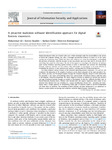A proactive malicious software identification approach for digital forensic examiners
| dc.contributor.author | Ali, M | |
| dc.contributor.author | Shiaeles, S | |
| dc.contributor.author | Clarke, N | |
| dc.contributor.author | Kontogeorgis, D | |
| dc.date.accessioned | 2019-07-28T01:18:23Z | |
| dc.date.issued | 2019-08 | |
| dc.identifier.issn | 2214-2126 | |
| dc.identifier.issn | 2214-2134 | |
| dc.identifier.uri | http://hdl.handle.net/10026.1/14705 | |
| dc.description.abstract |
Digital investigators often get involved with cases, which seemingly point the responsibility to the person to which the computer belongs, but after a thorough examination malware is proven to be the cause, causing loss of precious time. Whilst Anti-Virus (AV) software can assist the investigator in identifying the presence of malware, with the increase in zero-day attacks and errors that exist in AV tools, this is something that cannot be relied upon. The aim of this paper is to investigate the behaviour of malware upon various Windows operating system versions in order to determine and correlate the relationship between malicious software and OS artifacts. This will enable an investigator to be more efficient in identifying the presence of new malware and provide a starting point for further investigation. The study analysed several versions of the Windows operating systems (Windows 7, 8.1 and 10) and monitored the interaction of 90 samples of malware (across three categories of the most prevalent (Trojan, Worm, and Bot) and 90 benign samples through the Windows Registry. Analysis of the interactions has provided a rich source of knowledge about how various forms of malware interact with key areas of the Registry. Using this knowledge, the study sought to develop an approach to predict the presence and type of malware present through an analysis of the Registry. To this end, different classifiers such as Neural Network, Random forest, Decision tree, Boosted tree and Logistic regression were tested. It was observed that Boosted tree was resulting in a correct classification of over 72% – providing the investigator with a simple approach to determining which type of malware might be present independent and faster than an Antivirus. The modelling of these findings and their integration in an application or forensic analysis within an existing tool would be useful for digital forensic investigators. | |
| dc.format.extent | 139-155 | |
| dc.language | en | |
| dc.language.iso | en | |
| dc.publisher | Elsevier | |
| dc.subject | Digital forensics | |
| dc.subject | Malware | |
| dc.subject | Machine learning | |
| dc.subject | Registry hives | |
| dc.subject | Windows Registry | |
| dc.subject | Windows 7/8/10 | |
| dc.subject | Sandbox | |
| dc.subject | Agentless sandbox | |
| dc.subject | Cuckoo | |
| dc.title | A proactive malicious software identification approach for digital forensic examiners | |
| dc.type | journal-article | |
| dc.type | Article | |
| plymouth.author-url | https://www.webofscience.com/api/gateway?GWVersion=2&SrcApp=PARTNER_APP&SrcAuth=LinksAMR&KeyUT=WOS:000480387600017&DestLinkType=FullRecord&DestApp=ALL_WOS&UsrCustomerID=11bb513d99f797142bcfeffcc58ea008 | |
| plymouth.volume | 47 | |
| plymouth.publication-status | Published | |
| plymouth.journal | Journal of Information Security and Applications | |
| dc.identifier.doi | 10.1016/j.jisa.2019.04.013 | |
| plymouth.organisational-group | /Plymouth | |
| plymouth.organisational-group | /Plymouth/Faculty of Science and Engineering | |
| plymouth.organisational-group | /Plymouth/Faculty of Science and Engineering/School of Engineering, Computing and Mathematics | |
| plymouth.organisational-group | /Plymouth/REF 2021 Researchers by UoA | |
| plymouth.organisational-group | /Plymouth/REF 2021 Researchers by UoA/UoA11 Computer Science and Informatics | |
| plymouth.organisational-group | /Plymouth/Users by role | |
| plymouth.organisational-group | /Plymouth/Users by role/Academics | |
| dcterms.dateAccepted | 2019-05-16 | |
| dc.rights.embargodate | 2020-5-15 | |
| dc.identifier.eissn | 2214-2134 | |
| dc.rights.embargoperiod | Not known | |
| rioxxterms.versionofrecord | 10.1016/j.jisa.2019.04.013 | |
| rioxxterms.licenseref.uri | http://www.rioxx.net/licenses/all-rights-reserved | |
| rioxxterms.licenseref.startdate | 2019-08 | |
| rioxxterms.type | Journal Article/Review | |
| plymouth.funder | Cyber-Trust: Advanced Cyber-Threat Intelligence, Detection, and Mitigation Platform for a Trusted Internet of Things::European Commision - H2020 RIA |


